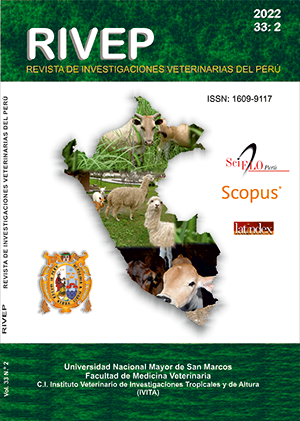Diseases of the ocular system diagnosed in dogs and cats from Havana, Cuba. Period 2014-2020
DOI:
https://doi.org/10.15381/rivep.v33i2.22589Keywords:
illnesses of the ocular system, dogs, catsAbstract
In Cuba, a study was carried out on diseases of the ocular system in dogs and cats in the period 2000-2013 in the specialized ophthalmology clinic of the main veterinary clinic in Havana, Cuba. Based on these results, the objective of this work was to describe the frequency of these eye diseases in the period 2014 to 2020. The sample was made up of 3186 dogs and 177 domestic cats (n=3363), which was stratified by breed, sexes, and ages. In dogs, it was determined that Pekingese breed (2070; 65%), females (1820; 57%) and animals between 1-5 years (1413; 44%) and 6 or more years (977; 31%) were the most affected. Conditions of the lacrimal system (69%), cornea (10%), eyelids (9%) and conjunctiva (7%) were most frequently diagnosed. In cats, it was found that American shorthairs (160; 90%), females (115; 65%) and animals between 1 and 5 years old (74; 42%) were the most affected. In this species, the main eye conditions were those of the cornea (28%), conjunctiva (22%), upper and lower eyelids (22%) and the third eyelid (19%).
Downloads
Downloads
Published
Issue
Section
License
Copyright (c) 2022 Beatriz Hugues, Miguel Torres

This work is licensed under a Creative Commons Attribution 4.0 International License.
AUTHORS RETAIN THEIR RIGHTS:
a. Authors retain their trade mark rights and patent, and also on any process or procedure described in the article.
b. Authors retain their right to share, copy, distribute, perform and publicly communicate their article (eg, to place their article in an institutional repository or publish it in a book), with an acknowledgment of its initial publication in the Revista de Investigaciones Veterinarias del Perú (RIVEP).
c. Authors retain theirs right to make a subsequent publication of their work, to use the article or any part thereof (eg a compilation of his papers, lecture notes, thesis, or a book), always indicating the source of publication (the originator of the work, journal, volume, number and date).



